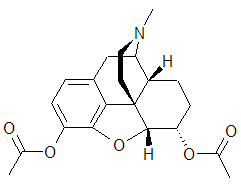Diacetyldihydromorphine: Difference between revisions
m (Bot: Automated text replacement (-{{SIB}} + & -{{EH}} + & -{{EJ}} + & -{{Editor Help}} + & -{{Editor Join}} +)) |
m (Robot: Automated text replacement (-{{WikiDoc Cardiology Network Infobox}} +, -<references /> +{{reflist|2}}, -{{reflist}} +{{reflist|2}})) |
||
| Line 34: | Line 34: | ||
== References == | == References == | ||
{{reflist|2}} | |||
{{opioids}} | {{opioids}} | ||
Latest revision as of 16:46, 4 September 2012
 | |
| Clinical data | |
|---|---|
| Synonyms | Diacetyldihydromorphine, Paralaudin, Dihydroheroin |
| Routes of administration | Intravenous |
| Legal status | |
| Legal status |
|
| Identifiers | |
| |
| CAS Number | |
| PubChem CID | |
| E number | {{#property:P628}} |
| ECHA InfoCard | {{#property:P2566}}Lua error in Module:EditAtWikidata at line 36: attempt to index field 'wikibase' (a nil value). |
| Chemical and physical data | |
| Formula | C21H25NO5 |
| Molar mass | 371.427 g/mol |
Diacetyldihydromorphine (Paralaudin, Dihydroheroin) is a potent opiate derivative developed in Germany in 1929 which is rarely used in some countries for the treatment of severe pain such as that caused by terminal cancer, as a more potent form of diamorphine (Heroin). Paralaudin is fast acting and longer lasting than diamorphine (heroin), with a duration of action of around 4-7 hours.
Diacetyldihydromorphine is quickly metabolised by plasma esterase enzymes into dihydromorphine, in the same way that diacetylmorphine (heroin) is metabolised into morphine; however unlike dihydromorphine, which is more potent than morphine as an analgesic, diacetyldihydromorphine is actually less potent than diamorphine, perhaps because it is metabolised more slowly. Diacetyldihydromorphine is approximately equipotent to morphine whereas diamorphine is twice the potency of morphine.[1] It shares with other opioids the risk of overdose or (potentially life-threatening) respiratory depression. When strong opioids are required it is more common to use better known drugs such as nicomorphine, oxymorphone or fentanyl which doctors will be more familiar with, and which do not share the stigma associated with heroin. Side effects are similar to those of other opiates and include itching, nausea and constipation.
References
- Pages with script errors
- E number from Wikidata
- ECHA InfoCard ID from Wikidata
- Chemical articles with unknown parameter in Infobox drug
- Articles without EBI source
- Chemical pages without ChemSpiderID
- Chemical pages without DrugBank identifier
- Articles without KEGG source
- Articles without InChI source
- Articles without UNII source
- Drugs missing an ATC code
- Articles containing unverified chemical infoboxes
- Opioids
- Drugs